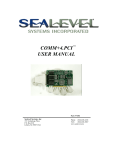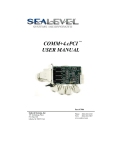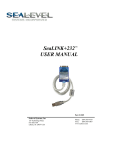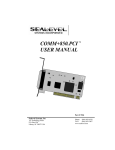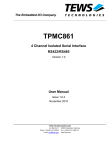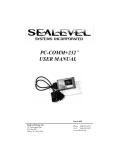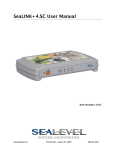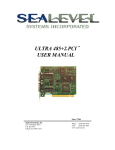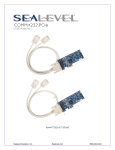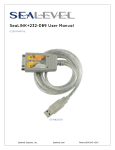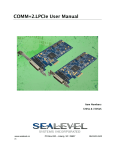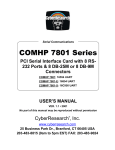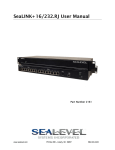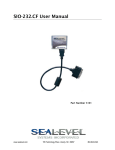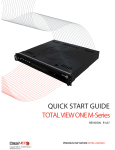Download 7905 User Manual
Transcript
TM COMM+8.cPCI USER MANUAL Part # 7905 Sealevel Systems, Inc P.O. Box 830 Liberty, SC 29657 USA Phone: (864) 843-4343 FAX: (864) 843-3067 www.sealevel.com Contents INTRODUCTION ........................................................................ 1 OVERVIEW......................................................................................1 WHAT’S INCLUDED ........................................................................1 CARD SETUP ............................................................................ 2 CLOCK MODES ...............................................................................2 BAUD RATES AND DIVISORS FOR THE ‘D1’ MODE ..........................3 ADDRESS AND IRQ SELECTION .......................................................3 INSTALLATION ......................................................................... 4 OPERATING SYSTEM INSTALLATION ...............................................4 For Windows Users ....................................................................4 Other Operating Systems ............................................................4 SYSTEM INSTALLATION ..................................................................4 TECHNICAL DESCRIPTION....................................................... 5 CONNECTOR PIN ASSIGNMENTS .....................................................5 DB-25 (RS-232 DTE) (DB25 MALE)....................................5 HD-68 CONNECTOR PIN ASSIGNMENTS (HD-68 FEMALE) .......5 SPECIFICATIONS ...................................................................... 6 ENVIRONMENTAL SPECIFICATIONS .................................................6 POWER CONSUMPTION ...................................................................6 MEAN TIME BETWEEN FAILURES (MTBF) .....................................6 PHYSICAL DIMENSIONS ..................................................................6 APPENDIX A - TROUBLESHOOTING ......................................... 7 APPENDIX B - HOW TO GET ASSISTANCE .............................. 8 APPENDIX C - ELECTRICAL INTERFACE ................................. 9 RS-232...........................................................................................9 APPENDIX D - ASYNCHRONOUS COMMUNICATIONS ............ 10 APPENDIX E - SILK-SCREEN.................................................. 11 APPENDIX F - COMPLIANCE NOTICES .................................. 12 FEDERAL COMMUNICATIONS COMMISSION STATEMENT ..............12 EMC DIRECTIVE STATEMENT ......................................................12 WARRANTY ............................................................................ 13 Figures Figure 1 - Clocking Mode ‘Divide By 4’ ..................................................2 Figure 2 - Clocking Mode ‘Divide By 1’ ..................................................2 Figure 3 - Asynchronous Communications Bit Diagram .....................10 © Sealevel Systems, Inc. SL9074 Revision 7/2006 Sealevel Systems, Incorporated. All rights reserved. Introduction Introduction Overview The Sealevel Systems COMM+8.cPCI is an eight-channel serial I/O adapter for Compact PCI compliant machines. The COMM+8.cPCI allows for connection to any device utilizing the RS-232 electrical interface, such as modems, data-entry terminals, and plotters. What’s Included The COMM+8.cPCI is shipped with the following items. If any of these items is missing or damaged, contact the supplier. • • • COMM+8.cPCI Serial I/O Adapter HD-68 to eight DB-25 ‘Spider Cable’ Sealevel Software Sealevel Systems COMM+8.cPCI Page 1 Card Setup Card Setup Clock Modes The COMM+8.cPCI employs a unique clocking option that allows the end user to select from divide by 4 and divide by 1 clocking modes. This mode is selected at J1. To select the Baud rates commonly associated with COM: ports (i.e. 2400, 4800, 9600, 19.2, … 115.2K Bps) place the jumper in the divide by 4 mode (silk-screen D4). D D 1 4 Figure 1 - Clocking Mode ‘Divide By 4’ To select the maximum data rate (460.8K bps) place the jumper in the divide by 1 (silk-screen D1) position. D D 1 4 Figure 2 - Clocking Mode ‘Divide By 1’ Sealevel Systems COMM+8.cPCI Page 2 Card Setup Baud Rates and Divisors for the ‘D1’ mode The following table shows some common data rates and the rates you should choose to match them if using the adapter in the ‘Div1’ mode. For this Data Rate 1200 bps 2400 bps 4800 bps 9600 bps 19.2K bps 57.6 K bps 115.2 K bps 230.4K bps 460.8K bps Choose this Data Rate 300 bps 600 bps 1200 bps 2400 bps 4800 bps 14.4K bps 28.8K bps 57.6 K bps 115.2 K bps If your communications package allows the use of Baud rate divisors, choose the appropriate divisor from the following table: For this Data Rate 1200 bps 2400 bps 4800 bps 9600 bps 19.2K bps 38.4K bps 57.6K bps 115.2K bps 230.4K bps 460.8K bps Choose this Divisor 384 192 96 48 24 12 8 4 2 1 Address and IRQ selection The COMM+8.cPCI is automatically assigned I/O addresses and IRQs by your motherboard BIOS. Only the I/O address may be modified by the user. Adding or removing other hardware may change the assignment of I/O addresses and IRQs. Sealevel Systems COMM+8.cPCI Page 3 Installation Installation Operating System Installation For Windows Users Start by choosing Install Software at the beginning of the CD. Choose Asynchronous COM: Port Software, SeaCOM. Other Operating Systems Refer to the appropriate section of the Serial Utilities Software. System Installation The COMM+8.cPCI can be installed in any of the cPCI expansion slots and contains configuration options for each port that must be set for proper operation. 1. 2. 3. 4. 5. 6. Turn off PC power. Disconnect the power cord. Locate an available cPCI slot and remove the blank metal slot cover. Gently insert the COMM+8.cPCI into the slot. Make sure that the adapter is seated properly. Replace the cover. Install the Cable (CA-191) Connect the power cord. Installation is complete. Sealevel Systems COMM+8.cPCI Page 4 Technical Description Technical Description The Sealevel Systems COMM+8.cPCI provides a PCI interface adapter with 8 RS-232 asynchronous serial ports for industrial automation and control applications. The COMM+8.cPCI utilizes the 16C864 UART. This chip features programmable baud rates, data format, interrupt control and industry leading 128-byte transmit and receive FIFOs. Connector Pin Assignments DB-25 (RS-232 DTE) Signal GND TD RTS DTR RD CTS DSR DCD RI (DB25 MALE) Name Ground Transmit Data Request To Send Data Terminal Ready Receive Data Clear To Send Data Set Ready Data Carrier Detect Ring Indicator Pin # 7 2 4 20 3 5 6 8 22 Mode Output Output Output Input Input Input Input Input Technical Note: Please terminate any control signals that are not going to be used. The most common way to do this is connect RTS to CTS and RI. Also, connect DCD to DTR and DSR. Terminating these pins, if not used, will help insure you get the best performance from your adapter. HD-68 Connector Pin Assignments (HD-68 Female) Port # TD RI DCD DTR RTS DSR RD CTS GND 1 1 2 3 4 5 6 7 8 17 2 9 10 11 12 13 14 15 16 17 3 19 20 21 22 23 24 25 26 18 Sealevel Systems COMM+8.cPCI 4 27 28 29 30 31 32 33 34 18 5 35 36 37 38 39 40 41 42 51 6 43 44 45 46 47 48 49 50 51 7 53 54 55 56 57 58 59 60 52 8 61 62 63 64 65 66 67 68 52 Page 5 Specifications Specifications Environmental Specifications Specification Temperature Range Humidity Range Operating 0º to 50º C (32º to 122º F) 10 to 90% R.H. Non-Condensing Storage -20º to 70º C (-4º to 158º F) 10 to 90% R.H. Non-Condensing Power Consumption Supply line Rating +12 VDC 125 mA -12 VDC 125 mA +5 VDC 210 mA Mean Time Between Failures (MTBF) Greater than 150,000 hours. (Calculated) Physical Dimensions The adapter conforms to the requirements of a 3U Adapter as set forth by the PCI SIG. Sealevel Systems COMM+8.cPCI Page 6 Appendix A - Troubleshooting Appendix A - Troubleshooting Sealevel Software is supplied with the Sealevel Systems adapter and will be used in the troubleshooting procedures. By using this software and following these simple steps, most common problems can be eliminated without the need to call Technical Support. 1. Identify all I/O adapters currently installed in your system. This includes your on-board serial ports, controller cards, sound cards etc. The I/O addresses used by these adapters, as well as the IRQ (if any) should be identified. 2. Make sure the Sealevel Systems adapter is securely installed in a motherboard slot. 3. When running DOS or Windows 3.x refer to the supplied Sealevel Software and this User Manual to verify that the Sealevel Systems adapter is configured correctly. This software contains a diagnostic program ‘SSD’ that will verify if an adapter is configured properly. This diagnostic program is written with the user in mind and is easy to use. 4. For Windows 95/98/ME/NT/2000/XP, the diagnostic tool ‘WinSSD’ is installed in the SeaCOM folder on the Start Menu during the setup process. First find the ports using the Device Manager, then use ‘WinSSD’ to verify that the ports are functional. 5. Always use the Sealevel Systems diagnostic software when troubleshooting a problem. This will eliminate any software issues from the equation. Sealevel Systems COMM+8.cPCI Page 7 Appendix B - How To Get Assistance Appendix B - How To Get Assistance Please refer to Troubleshooting Guide prior to calling Technical Support. 1. Read this manual thoroughly before attempting to install the adapter in your system. 2. When calling for technical assistance, please have your user manual and current adapter settings. If possible, please have the adapter installed in a computer ready to run diagnostics. 3. Sealevel Systems maintains a Home page on the Internet. Our home page address is www.sealevel.com. The latest software updates, and newest manuals are available via our FTP site that can be accessed from our home page. 4. Technical support is available Monday to Friday from 8:00 a.m. to 5:00 p.m. eastern time. Technical support can be reached at (864) 843-4343. RETURN AUTHORIZATION MUST BE OBTAINED FROM SEALEVEL SYSTEMS BEFORE RETURNED MERCHANDISE WILL BE ACCEPTED. AUTHORIZATION CAN BE OBTAINED BY CALLING SEALEVEL SYSTEMS AND REQUESTING A RETURN MERCHANDISE AUTHORIZATION (RMA) NUMBER. Sealevel Systems COMM+8.cPCI Page 8 Appendix C - Electrical Interface Appendix C - Electrical Interface RS-232 Quite possibly the most widely used communication standard is RS-232. This implementation has been defined and revised several times and is often referred to as RS-232-C/D/E or EIA/TIA-232-C/D/E. It is defined as “Interface between Data Terminal Equipment and Data Circuit- Terminating Equipment Employing Serial Binary Data Interchange”. The mechanical implementation of RS-232 is on a 25-pin D sub connector. The IBM PC computer defined the RS-232 port on a 9 pin D sub connector and subsequently the EIA/TIA approved this implementation as the EIA/TIA-574 standard. This standard has defined as the “9-Position Non-Synchronous Interface between Data Terminal Equipment and Data Circuit-Terminating Equipment Employing Serial Binary Data Interchange”. Both implementations are in wide spread use and will be referred to as RS-232 in this document. RS-232 is capable of operating at data rates up to 20K bps / 50 ft. The absolute maximum data rate may vary due to line conditions and cable lengths. RS-232 often operates at 38.4K bps over very short distances. The voltage levels defined by RS-232 range from -12 to +12 volts. RS-232 is a single ended or unbalanced interface, meaning that a single electrical signal is compared to a common signal (ground) to determine binary logic states. A voltage of +12 volts (usually +3 to +10 volts) represents a binary 0 (space) and -12 volts (-3 to -10 volts) denote a binary 1 (mark). The RS-232 and the EIA/TIA-574 specification define two types of interface circuits Data Terminal Equipment (DTE) and Data Circuit-Terminating Equipment (DCE). The Sealevel Systems Adapter is a DTE interface. Sealevel Systems COMM+8.cPCI Page 9 Appendix D - Asynchronous Communications Appendix D - Asynchronous Communications Serial data communications implies that individual bits of a character are transmitted consecutively to a receiver that assembles the bits back into a character. Data rate, error checking, handshaking, and character framing (start/stop bits) are pre-defined and must correspond at both the transmitting and receiving ends. Asynchronous communications is the standard means of serial data communication for PC compatibles and PS/2 computers. The original PC was equipped with a communication or COM: port that was designed around an 8250 Universal Asynchronous Receiver Transmitter (UART). This device allows asynchronous serial data to be transferred through a simple and straightforward programming interface. A starting bit followed by a pre-defined number of data bits (5, 6, 7, or 8) defines character boundaries for asynchronous communications. The end of the character is defined by the transmission of a pre-defined number of stop bits (usually 1, 1.5 or 2). An extra bit used for error detection is often appended before the stop bits. Idle state of line 5 to 8 Data Bits Odd, Even or Unused Remain Idle or next start bit 1 P BIT STOP 0 1 1.5 2 Figure 3 - Asynchronous Communications Bit Diagram This special bit is called the parity bit. Parity is a simple method of determining if a data bit has been lost or corrupted during transmission. There are several methods for implementing a parity check to guard against data corruption. Common methods are called (E)ven Parity or (O)dd Parity. Sometimes parity is not used to detect errors on the data stream. This is refereed to as (N)o parity. Because each bit in asynchronous communications is sent consecutively, it is easy to generalize asynchronous communications by stating that each character is wrapped (framed) by pre-defined bits to mark the beginning and end of the serial transmission of the character. The data rate and communication parameters for asynchronous communications have to be the same at both the transmitting and receiving ends. The communication parameters are baud rate, parity, number of data bits per character, and stop bits (i.e. 9600,N,8,1). Sealevel Systems COMM+8.cPCI Page 10 Appendix E - Silk-Screen Appendix E - Silk-Screen Sealevel Systems COMM+8.cPCI Page 11 Appendix F - Compliance Notices Appendix F - Compliance Notices Federal Communications Commission Statement FCC - This equipment has been tested and found to comply with the limits for Class A digital device, pursuant to Part 15 of the FCC Rules. These limits are designed to provide reasonable protection against harmful interference when the equipment is operated in a commercial environment. This equipment generates, uses, and can radiate radio frequency energy and, if not installed and used in accordance with the instruction manual, may cause harmful interference to radio communications. Operation of this equipment in a residential area is likely to cause harmful interference in such case the user will be required to correct the interference at his own expense. EMC Directive Statement Products bearing the CE Label fulfill the requirements of the EMC directive (89/336/EEC) and of the low-voltage directive (73/23/EEC) issued by the European Commission. To obey these directives, the following European standards must be met: • EN55022 Class A - “Limits and methods of measurement of radio interference characteristics of information technology equipment” • EN55024-‘Information technology equipment characteristics Limits and methods of measurement. Immunity • EN60950 (IEC950) - “Safety of information equipment, including electrical business equipment” technology Warning This is a Class A Product. In a domestic environment this product may cause radio interference in which case the user may be required to take adequate measures. Always use cabling provided with this product if possible. If no cable is provided or if an alternate cable is required, use high quality shielded cabling to maintain compliance with FCC/EMC directives. Sealevel Systems COMM+8.cPCI Page 12 Warranty Warranty Sealevel Systems, Inc. provides a lifetime warranty for this product. Should this product fail to be in good working order at any time during this period, Sealevel Systems will, at it's option, replace or repair it at no additional charge except as set forth in the following terms. This warranty does not apply to products damaged by misuse, modifications, accident or disaster. Sealevel Systems assumes no liability for any damages, lost profits, lost savings or any other incidental or consequential damage resulting from the use, misuse of, or inability to use this product. Sealevel Systems will not be liable for any claim made by any other related party. RETURN AUTHORIZATION MUST BE OBTAINED FROM SEALEVEL SYSTEMS BEFORE RETURNED MERCHANDISE WILL BE ACCEPTED. AUTHORIZATION CAN BE OBTAINED BY CALLING SEALEVEL SYSTEMS AND REQUESTING A RETURN MERCHANDISE AUTHORIZATION (RMA) NUMBER. Sealevel Systems, Incorporated 2779 Greenville Highway P.O. Box 830 Liberty, SC 29657 USA (864) 843-4343 FAX: (864) 843-3067 www.sealevel.com email: [email protected] Technical Support is available from 8 a.m. to 5 p.m. Eastern time. Monday - Friday Trademarks Sealevel Systems, Incorporated acknowledges that all trademarks referenced in this manual are the service mark, trademark, or registered trademark of the respective company. Sealevel, Sealevel Software and Sealevel Systems are registered trademarks of Sealevel Systems, Incorporated. COMM+8.cPCI is a trademark of Sealevel Systems, Incorporated. Sealevel Systems COMM+8.cPCI Page 13
















